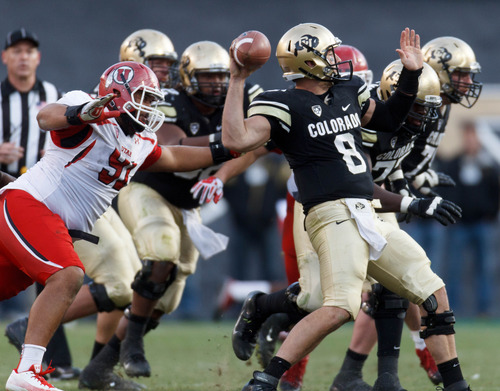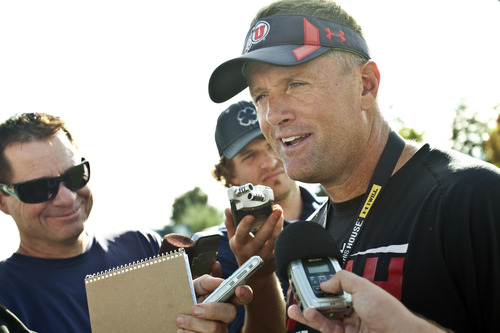This is an archived article that was published on sltrib.com in 2013, and information in the article may be outdated. It is provided only for personal research purposes and may not be reprinted.
Several years ago, when Urban Meyer was coaching the Utes and Kyle Whittingham was the defensive coordinator, the two talked about the changing trends in offense and decided they'd better be prepared. So they put a priority on speed and athleticism in the defense.
"We saw what was coming for a lot of years," Whittingham said. "Everyone wants the fast guys."
This year, more than ever, the Utes will find out just how well those efforts to be ahead of the curve have paid off.
The Utes might be known for their 4-3 defense, the scheme Fred Whittingham originally put in place under Ron McBride and his son, Kyle, honed under both McBride and Meyer.
But as the offenses go to more and more multiple looks, so too, do defenses.
The Utes have strayed occasionally from their base defense in the past, perhaps most notably two years ago when they surprised BYU with a 3-4 scheme. But this year they anticipate using it even less as they work on a variety of looks.
Utah defensive coordinator Kalani Sitake ticks off the schemes Utah plans to use like some kind of grocery list.
"We have a 4-3, a 3-4, a 4-2-5 and a 5-3," Sitake said. "The good teams now are doing a lot of bubble stuff out there so you have to be ready. But what you don't want to do is be a jack of all trades and a master of none."
To prevent such from happening the Utes still have plenty of size in the middle with tackles Tenny Palepoi (6-2, 300), L.T. Tuipulotu (6-1,305), Sese Ianu (6-2, 305), Latu Heimuli (6-3, 305) and Stevie Tu'ikolovatu (6-1, 320), all sporting the kind of heft that Whittingham frequently refers to as "space eaters."
But outside, on the edges, the Utes have gone more for agility and speed. Prepare to hear the term "hybrid" in relation to the defense as much as the offense. Players such as Nate Orchard (6-3, 255), Jason Whittingham (6-2, 240), Thretton Palamo (6-2, 255) and Trevor Reilly (6-5, 255) all fit the template the Utes want at defensive end. They are fast, versatile players who can get to quarterbacks off the edge, but also can drop off into coverage.
Watching the Utes practice last week, former UCLA coach Rick Neuheisel believes Utah is moving in the right direction. He noted the change in emphasis will not only help the Utes immediately on the field, but also in future recruiting classes as the program continues to create a foothold in the competitive Pac-12 recruiting areas.
"It's hard to find the great defensive line players," he said. "Utah has done a good job of that, but you can get more of the Nate Orchard types so it becomes easier to recruit that position."
Spreading the defense out in response to the multiple looks offenses are showing now means the Utes have to be more flexible. Using the 4-2-5 will require safeties who can support the run, but also the kind of guys whose strength is better pass coverage. The result? Players who can play defensive end/linebacker and linebacker/defensive back.
The versatility could be problematic for a team that doesn't have much depth in its secondary, but Utah's coaches believe they have the personnel.
Using more nickel and dime packages, with five to seven defensive backs on the field, will allow the Utes to use a lot of different combinations. Expect to see freshman Justin Thomas and senior Michael Walker a lot at nickel.
"That guy has to be tough and know the schemes," Sitake said. "He has to be a corner/safety/backer so it demands a lot from that guy but they are figuring it out."
What you won't see so much anymore are the formations the Utes were known for in the past. The 4-3 might be what Kyle Whittingham literally grew up with in his family, but it's time for a change, he said.
"Football is evolving and you have to go in a different direction," said Whittingham. "The offense sets the trend and the defense follows suit and the spread offense necessitates the defense adapt. Basically you won't see three-linebacker defense anymore, it just doesn't lend itself to these offenses."
As much talk as there is of change, former defensive line coach John Pease, who spent more than 20 years coaching in the NFL, said the basics still remain the same.
"You still have to have the ability to stop the run," he said. "You have a stepped-up game on the perimeter because these guys are so much faster and there is speed all over the field. But then look at a team like Stanford, that is 1957 offensively, it's a power, we are going to knock your teeth out offense and guess what, they do. You still have to stop the run first, that is the one thing that has carried over. If you can stop the run and cover the passer, you're going to be OK."
Camp Corner
Who was hot • Utah's defense had a solid effort Monday morning, particularly the linebackers, in coach Kyle Whittingham's estimation.
Who was off • Corner Keith McGill continues to be sidelined with a concussion and defensive lineman Stevie Tu'ikolovatu left practice early with a foot injury.
What is up next • The Utes scrimmage Tuesday morning with an emphasis on the run game.





